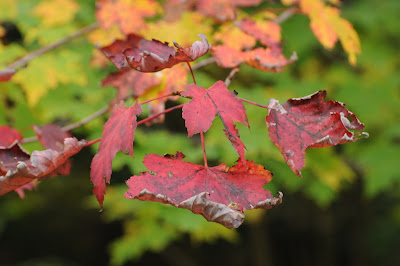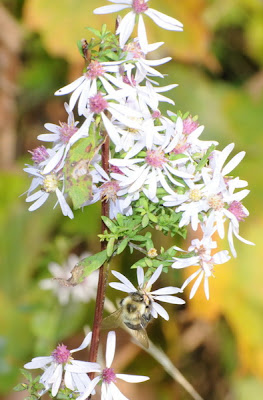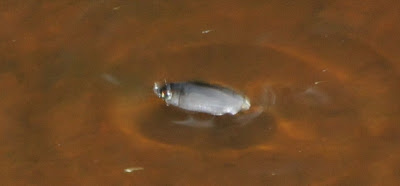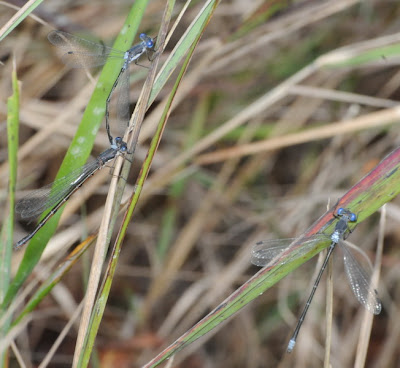On the last weekend in September (September 26-28, 2011), Eileen and I made a second, and very welcome, visit to Robert and Norma's cottage on Basshaunt Lake.
By now it was autumn, and the leaves had begun to turn colour - that annual phenomenon that is one of the glories of our province.
Despite its beauty, Autumn is a time when many of the living things of the woodlands become less active and obvious. Some reach the end of their brief life cycles; others prepare for the coming winter by seeking out spots to lie dormant or (as for many of the birds) disappearing on migrations elsewhere.
In late September, though, autumn is only beginning. Many of the birds - leaf-gleaning insect-eaters like the wood warblers - have already left, but you can still find summer creatures, including the Green Frogs (Lithobates clamitans) I had seen in June.
Some insects are still active. Wasps of the genus Vespula and their relatives - the insects we North Americans call yellowjackets - seek nectar from autumn flowers like this Blazing Star (Liatris sp.), probably a garden escapee. There are two species here: the upper is probably an Eastern Yellowjacket (Vespula maculifrons) and the lower, a Bald-faced Hornet (Dolichovespula maculata), which is actually a largeish yellowjacket rather than a hornet. Yellowjackets are colonial insects; of the thousands that fill a colony during the summer, only the queen will seek out an overwintering site and survive until the following spring.
I was curious to see which, if any, dragonflies or damselflies might still be on the wing this late in the season, so I set off on our first morning to check out my favourite beaver pond, photographing attractive arrangements of autumn vegetation along the way.
Sugar Maples (Acer saccharum) were already taking on the bright colours that add most of the brilliance to Ontario's autumn leaf spectacle.
Shoots of Ground Pine (Lycopodium obscurum) poked up through the dry leaf litter - not miniature pine trees, but plants of a far more ancient lineage. The Ground Pine is a clubmoss, a "fern ally" whose distant ancestors, over 300 million years ago, grew to tree height in of the forests of the Coal Age.
Autumn, besides being the season of colourful leaves and departing birds, is the best time to find mushrooms. Identifying them is a skill I don't possess - and one you need to acquire if you plan to eat any of these, something I certainly wouldn't try with the white ones at the bottom in case they are among the poisonous species of the genus Amanita (and I'm not saying they are).
You're on a bit safer ground with puffballs, but even some of these can be confused with some of the nastier Amanitas. This looks like the widespread Lycoperdon pyriforme, an almost worldwide species, but I didn't examine it in detail and it could be something else.
At the end of my walk, I was in for a shock and a disappointment: the beaver pond had been drained! The once-rich dragonfly habitat and amphibian breeding ground I had visited only three months earlier (and which I celebrated in my last two posts) was gone.
Here is the culprit's bulldozer, at rest after chewing up and otherwise despoiling the area. Rats.
There wasn't much more to be done, so I checked out maps of the area for an alternative. Fortunately, after short drive I found a new spot where a dirt road crossed a narrow neck linking two parts of nearby West Lake.
Now, this was more like it!
The drowned trees suggest that this, too, was a beaver pond, but a much larger, deeper and more substantial one than the wreck of my old site.
It certainly had beavers, builders and owners of a quite substantial lodge out on the water.
Here, there were still insects in abundance. Whirligig beetles (Family Gyrinidae) danced over the surface...
And here, finally, there were damselflies and dragonflies. The dragonflies were a surprise - I saw none of the common skimmers of the family Libellulidae that had dominated the dragonfly fauna on my previous visits. Their summer was done; but the darners (Aeshnidae) were still active, laying last clutches of eggs before the colder weather set in. Darners can be hard to come to terms with. Unlike libellulids, they spend most of their day on the wing, and when they do perch it is, as often as not, high in a tree where they hang vertically rather than sitting horizontally as, say, skimmers do.
Finally, though, I spotted a perched Darner - or rather, a rival spotted it for me as it tried to chase it from its chosen perch atop a dead spar. It's hard to tell from a distance (darners can be tricky to identify), but I believe this is a Canada Darner (Aeshna canadensis).
The only damselfly I found was the Spotted Spreadwing (Lestes congener), a late-flying species whose numbers peak in September. Like the other spreadwings (Lestidae), it holds its wings partly open when it perches. Notice the blue eyes!
The mating male had a firm grip on his mate. In case this looks rather odd for a mating position - surely he has her by the wrong end? - this is the way odonates do things. The male's sperm is indeed produced from an opening near the end of his abdomen, on the ninth abdominal segment - but before he approaches a female he transfers the sperm to a set of secondary appendages on the underside of his second abdominal segment, not far behind the thorax. Now he is ready to seize the female behind the head, gripping her with a set of appendages at the tip of his abdomen. This is the tandem position. For mating to be successful, the female must curve her abdomen forward and collect the sperm from the male's secondary appendages (assuming the wheel position).
Dragonflies and damselflies are the only insects to go through such a complicated rigmarole, and the clue as to why they do it lies in the fact that the male's cerci and paraprocts, the organs he uses to grip the female, differ in shape and configuration from species to species, as does the shape of the area he grips on the female. Each species can, it seems, only lock on successfully to one of its own kind. The shape of these organs is crucial to mating success, and may be a way to prevent mating with the wrong species.
This can all work very well if there are only two insects involved. However, a courting couple may not be left alone: in this case, a rival male repeatedly tried to horning on the mating pair, but, apparently, without success.
Mating was already a fait accompli for this dragonfly - another aeshnid, this time, apparently, a Black-tipped Darner (Aeshna tuberculifera). I watched her repeatedly depositing her eggs in the gathering dusk. Whereas most dragonflies simply drop their eggs in the water, often in hovering flight as they dip the tips of their abdomens beneath the surface, aeshnids usally lay their eggs in the stems of water plants such as rushes, clinging to the vegetation as they do so and digging into the plant's tissues with their ovipositors.
This female Darner had chosen a clump of bur-reed (Sparganium sp) as the repository for her eggs. As I watched, she hovered over the reeds, carefully selecting her spot before perching and quickly backing herself down into the water until her entire abdomen was submerged. There, she pumped out her eggs, her exertions betrayed by tiny ripples of water radiating away from her. After a few minutes of this, she moved on to another spot, and then another, as I tried to jockey myself into position for a clear view without pitching headfirst into the pond.
As I watched the darner an occasional slap on the water reminded me that I, too, was being watched. Apparently the beavers decided that I was not a threat, as one finally swam placidly by me. I photographed it in the waning light before heading, happily, back to the cottage.










































No comments:
Post a Comment